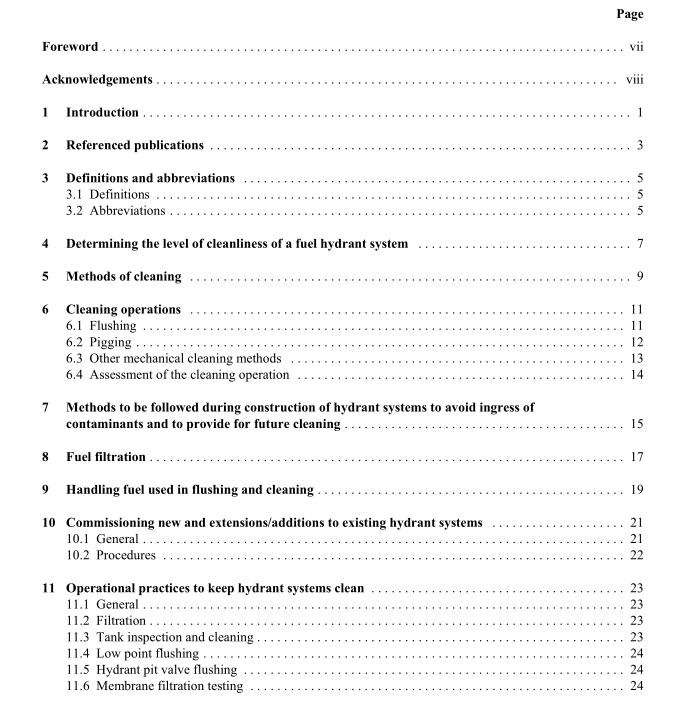API IP 1585 pdf download

API IP 1585 pdf download GUIDANCE IN THE CLEANING OF AIRPORT HYDRANT SYSTEMS
6.1.7 If high flow flushing back to a tank is undertaken, it is necessary to ensure that the venting capacity of the tank is not exceeded. If there is any doubt, a roof manhole, dip hatch or other top opening should be opened during the receipt of the fuel.
6.1.8 Fuel conductivity should be considered, see Section 13 and Table B1.
6.1.9 If a ‘return to tank’ system is not possible, the flushing should be carried out through the system, preferably into temporary fixed tankage. Where temporary fixed tankage cannot be provided, tank vehicles or refuellers can be used, but the limited flushing volume makes the associated operational and safety aspects more difficult to manage. As there may be limited refueller capacity at airports with a hydrant system, the use of outside road tank vehicles should be considered. The flushing tanks need to be in a clean condition, or be able to be cleaned to this standard, to allow the product to be returned to normal jet fuel storage. If this is not possible, the flushed product may have to be downgraded to non-aviation use unless it is confirmed by laboratory testing against the relative fuel specification that it is fit for use in aircraft.
6.1.10 To achieve the high flow, it may be necessary to install a manifold at the end of the line to be flushed so that the fuel may be pumped into more than one temporary tank, into the compartments of a single vehicle, or into more than one vehicle.
6.1.11 It is recommended that at least two, preferably three, times the capacity of the section being cleaned, be flushed at the fastest flow velocity achievable. Up to 3 m/sec is desirable.
6.1.12 Where there is a shortage of access points some types of low point may be converted for flushing by removing the small sampling/flushing line and installing a pit valve on the riser. In this way, a faster flow through the hydrant system is possible. If a low point is used, the dry-break should be removed to avoid damage, jamming with debris etc.
6.1.13 After each flushing sequence, low points should be checked for cleanliness (with ‘sample tubes’ replaced, if removed as in 6.1.12).
6.1.14 Where a hydrant is looped back to storage tankage, the flushing should be undertaken in one direction until clean and then, if possible, the flow reversed and the flushing continued until the product is again clean. In large hydrants, experience shows that flowing in one direction is not always sufficient to completely clean the system.
6.1.15 Those involved in flushing operations should decide whether to remove the pit valves on the risers used to connect to the receiving vehicle, or to leave them in place. It is recommended that if flushing into vehicles, the pit valves should be left in place. If flushing into a larger capacity fixed tank, the pit valves may be removed provided that a ball or other quick acting valve is installed in a readily accessible position, not in the pit. 6.1.16 If it is known that the system contains levels of particulate that could cause damage to, or malfunction of, the pit valves, they should be removed and an alternate means of stopping fuel flow provided, see 6.1.15 and 10.2.8.
6.2 PIGGING
6.2.1 Pigging is a very efficient way of cleaning but it will require much preparation work if the system was not originally designed to be pigged. Safety procedures will have to be put in place. Only soft pigs should be considered.
6.2.2 Any obstructions within the diameter of the pipe, for example, low point probes that pass through the diameter of the pipe, if not removable, will prevent the passage of a pig. A means of entering and removing the pig needs to be provided. 6.2.3 If pigging is to be carried out, pigs that are flexible enough to negotiate bends that may be present, such as soft foam pigs or polypigs, should be considered. Experience shows that soft foam pigs are very flexible; for example, a 30 cm (12 inch) pig will negotiate an 20 cm (8 inch) line. A pig with polyurethane bands fitted may be used; this will not damage the internal lining if it is in good condition.









